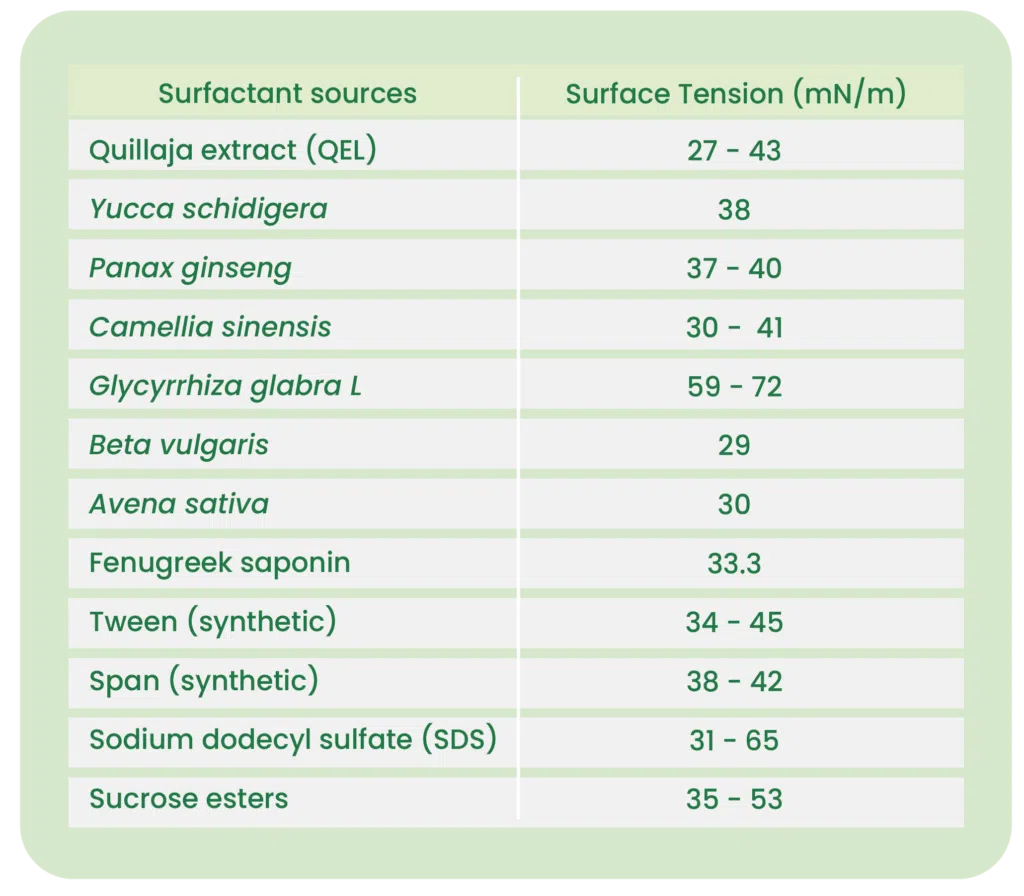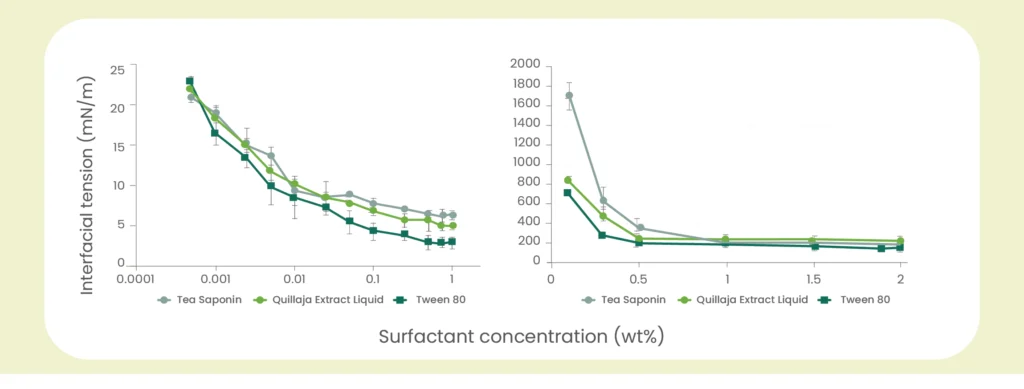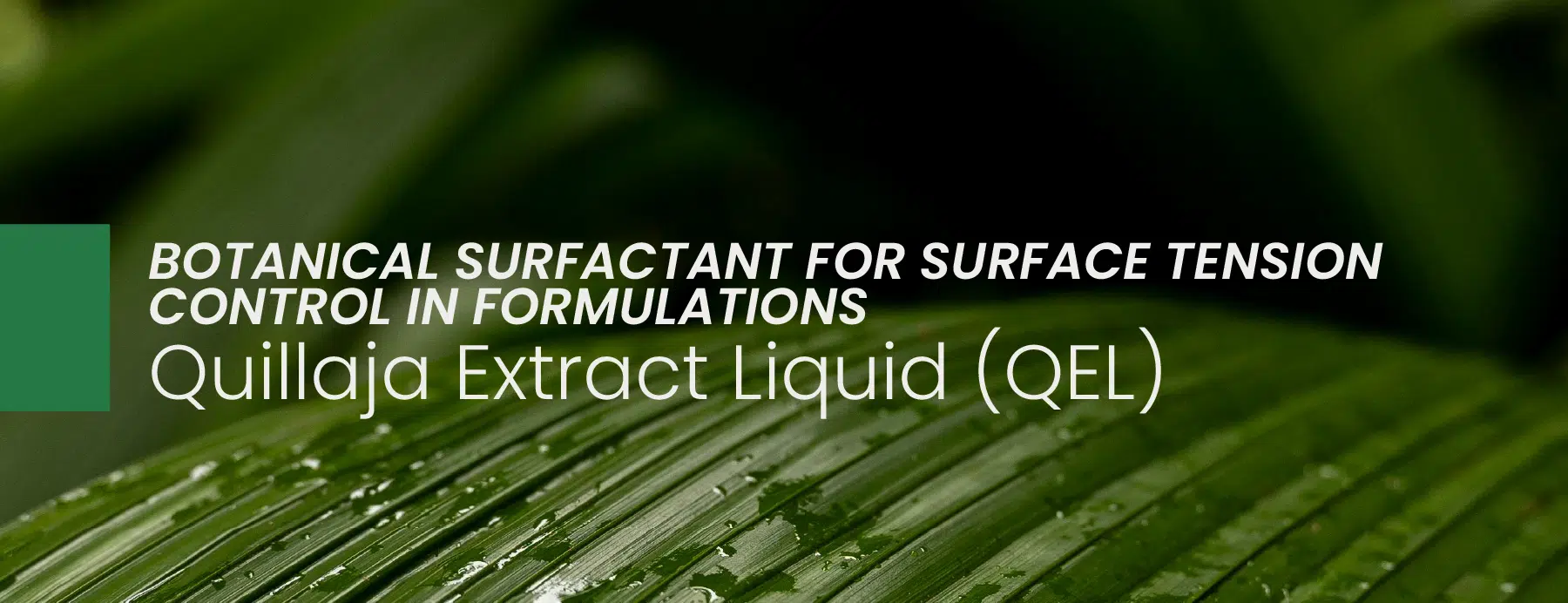Why Surface Tension Drives Agrochemical Performance?
Surfactants play a fundamental role in agrochemical formulations. Surface tension governs how solutions behave on plant surfaces: how they spread, adhere, penetrate the cuticle, and ultimately deliver active ingredients. Formulations with inadequate surfactants result in uneven deposition, lower uptake, and reduced efficacy, especially under water stress or low-volume spray conditions.
Among available options, Quillaja saponaria extract (QEL) stands out. Derived from a renewable botanical source, it combines:
- High-efficiency surface and interfacial tension reduction
- Broad formulation compatibility
- Multifunctionality (surfactant + permeabilizer + bioactive matrix)
Unlike synthetic surfactants, QEL is biodegradable, OMRI-listed, and exempt under EPA 25(b) as an inert ingredient.
Surface Tension Reduction: Scientifically Benchmarked
Water has a natural surface tension of approximately 72 mN/m. Effective surfactants lower this value to enable better droplet spread and contact. According to multiple literature sources, QEL reduces surface tension to as low as 27 mN/m, performing on par or better than synthetic and plant-based competitors.

Included for scientific benchmarking only. QEL is the only extract listed with agricultural approvals (OMRI, FIFRA 25(b)).
This performance is particularly relevant in low-dose applications where surfactant efficiency determines product effectiveness.
Interfacial Tension (IFT): Stability and Delivery
Beyond surface tension, interfacial tension (IFT) is key to emulsification and active ingredient delivery, especially in oil-based or biological formulations.
According to Zhu et al. (2019), Quillaja saponins showed:

- Lower IFT than Tea saponins or Tween 80
- Higher resistance to droplet coalescence
- Better interfacial film elasticity and stability
This makes QEL suitable for:
- Nanoemulsions and SCs (Suspension Concentrates)
- ECs (Emulsifiable Concentrates)
Oil-based adjuvants or carriers for lipophilic actives
Why QEL works in real formulations
Saponins from Quillaja saponaria belong to the triterpenoid class, structurally more complex and surface-active than steroidal saponins (e.g., from Yucca).
What makes triterpenic saponins superior?
- Aglycone structure: based on quillaic acid, creating stronger amphiphilic behavior.
- Multiple sugar chains: increase water solubility and micelle stability.
- Higher surface activity: leads to better film formation, lower CMC, and broader HLB range.
Vincken et al., 2007; Oda et al., 2003; Holka & Kowalska, 2023
These properties make QEL more efficient at lower doses, with improved coverage, adhesion, and compatibility.
CMC, HLB, and Application Versatility
Two key surfactant parameters define formulation behavior:
1. CMC – Critical Micelle Concentration
- QEL’s CMC ranges from 0.01 to 0.77 g/L depending on saponin purity.
- Low CMC = high activity at low concentrations.
- Important in concentrated and low-volume formulations.
2. HLB – Hydrophilic-Lipophilic Balance
- Estimated range for QEL: 13.2–36.3, depending on composition.
- Suitable for oil-in-water emulsions and multicomponent biological products.
Xu et al., 2021; Salminen et al., 2020
Membrane Permeabilization: A Critical Agronomic Mechanism
One of QEL’s most powerful biological mechanisms is its ability to enhance membrane permeability, especially relevant in foliar and seed-applied products.
How it works:
- Saponins insert into lipid bilayers, increasing membrane fluidity or forming reversible pores.
- Interaction with cholesterol and phospholipids alters the barrier function, increasing passive diffusion.
- Promotes entry of:
- Nutrients (Ca, Fe, Zn)
- Foliar pesticides
- Biostimulants and amino acids
Inoue & Nagai, 2016; McClements, 2017; Haralampidis et al., 2002
This effect supports higher active uptake, especially under suboptimal spray conditions or in crops with waxy leaves (e.g., grape, citrus, tomato).
Plant Bioactivity: More Than Just a Surfactant
Unlike synthetic surfactants, QEL is derived from a botanically rich matrix that includes:
- Flavonoids and polyphenols → defense and antioxidant activation
- Tannins → antimicrobial properties
- Saponins → abiotic stress modulation and signaling effects
Literature-based effects include:
- Enhanced antioxidant enzyme activity
- Activation of Systemic Acquired Resistance (SAR)
- Better tolerance to salinity, drought, and oxidative stress
Schmidt et al., 2010; Sci, 2021, 3(1), 44; Vincken et al., 2007
This positions QEL not only as a surfactant, but also as a biologically active enhancer for modern integrated solutions.
Soil and Rhizosphere Benefits
QEL is not only effective on plant surfaces, it also provides important benefits in the soil environment, particularly when used in fertigation, drenches, or seed treatments.
Confirmed effects include:
- Improved water infiltration and horizontal distribution in compact or hydrophobic soils
- Enhanced nutrient availability and mobility (especially phosphorus and micronutrients)
- Support of microbial activity, improving rhizosphere health
- Compatibility with PGPR (Plant Growth-Promoting Rhizobacteria)
Schmidt et al., 2023; Chilean Journal of Agricultural and Animal Sciences, 79(3)
These properties position QEL as a soil enhancer in addition to its surfactant function, particularly relevant in regenerative agriculture and biological programs.
Compatibility with Other Inputs
QEL exhibits excellent compatibility across a range of product types:
Works well with:
- Micronutrients (Ca, Fe, Zn, Mn)
- Amino acid and kelp-based biostimulants
- Biopesticides (e.g., Bacillus, Trichoderma)
- Copper-based fungicides and sulfur
- Botanical extracts and oils
- Humic and fulvic acids
Why?
- Non-ionic behavior: stable across pH and ionic strengths
- Low foaming: suitable for spray systems
- Biodegradable: doesn’t interfere with microbial viability
This makes QEL ideal for use in tank mixes, premixes, and multicomponent formulations.
Xu et al., 2021; Holka & Kowalska, 2023; Salminen et al., 2020
Regulatory and Sustainability Highlights
QEL is fully aligned with the requirements of sustainable and organic agriculture:
- OMRI-listed: allowed in certified organic production
- FIFRA 25(b): classified as a minimum-risk inert ingredient
- Biodegradable: no long-term environmental persistence
- Low toxicity to beneficials: including bees, earthworms, and soil microbes
Its clean regulatory profile makes QEL export-friendly and well-suited for residue-restricted programs in fruit, vegetable, and wine production.
Strategic Summary: Why Formulate with QEL?
If you are a formulator, QEL offers:
- High-efficiency surface and interfacial tension reduction
- Lower required concentrations (cost-effective and space-saving)
- Multifunctionality: surfactant + adjuvant + plant-compatible bioactives
- Compatibility across a wide range of ingredients
- Regulatory clarity for global compliance
References:
Discover how QEL can elevate your formulations — as a surfactant, penetration aid, and bioactive ally for sustainable agriculture. Get in touch with our team to learn more.


